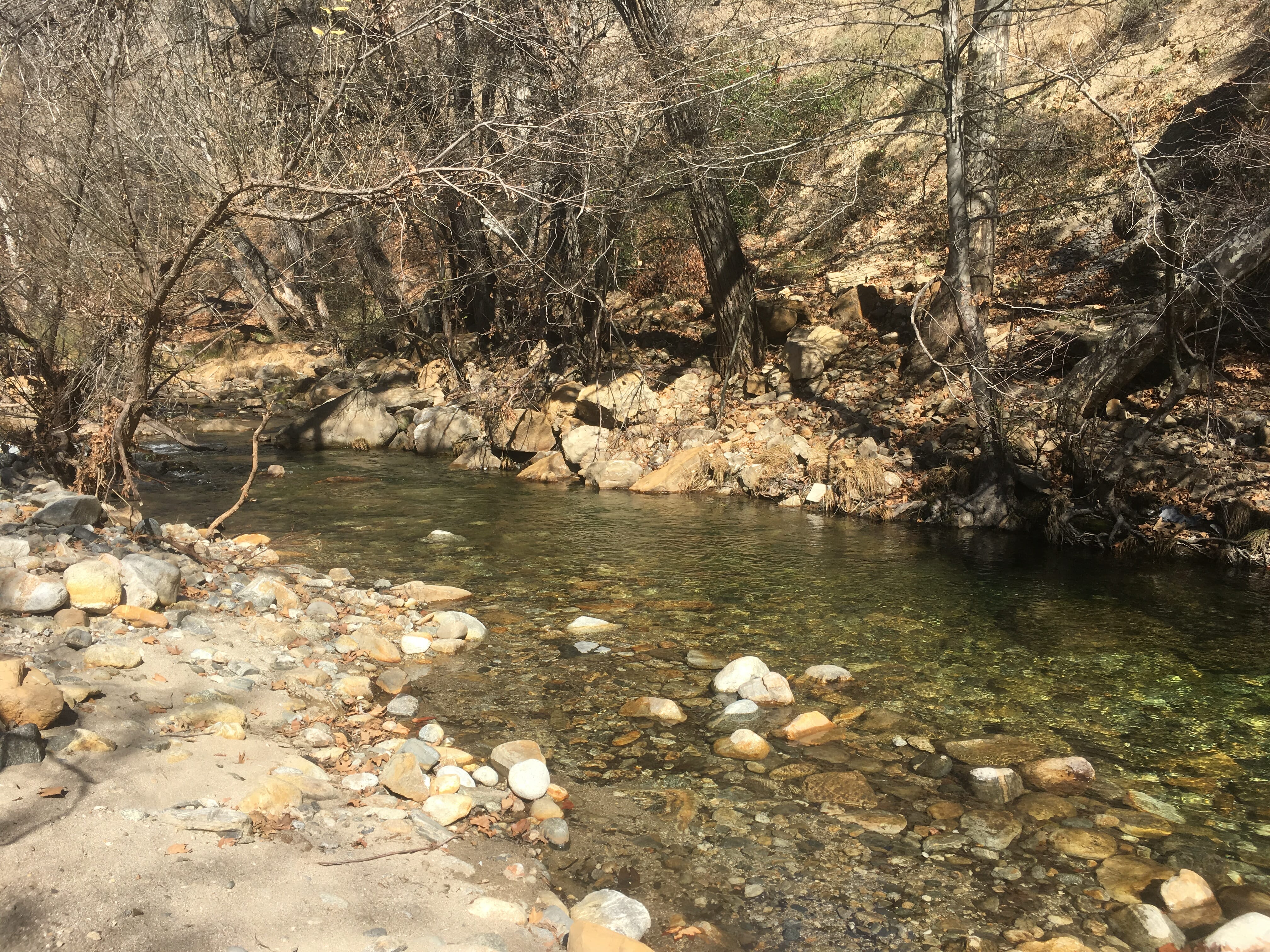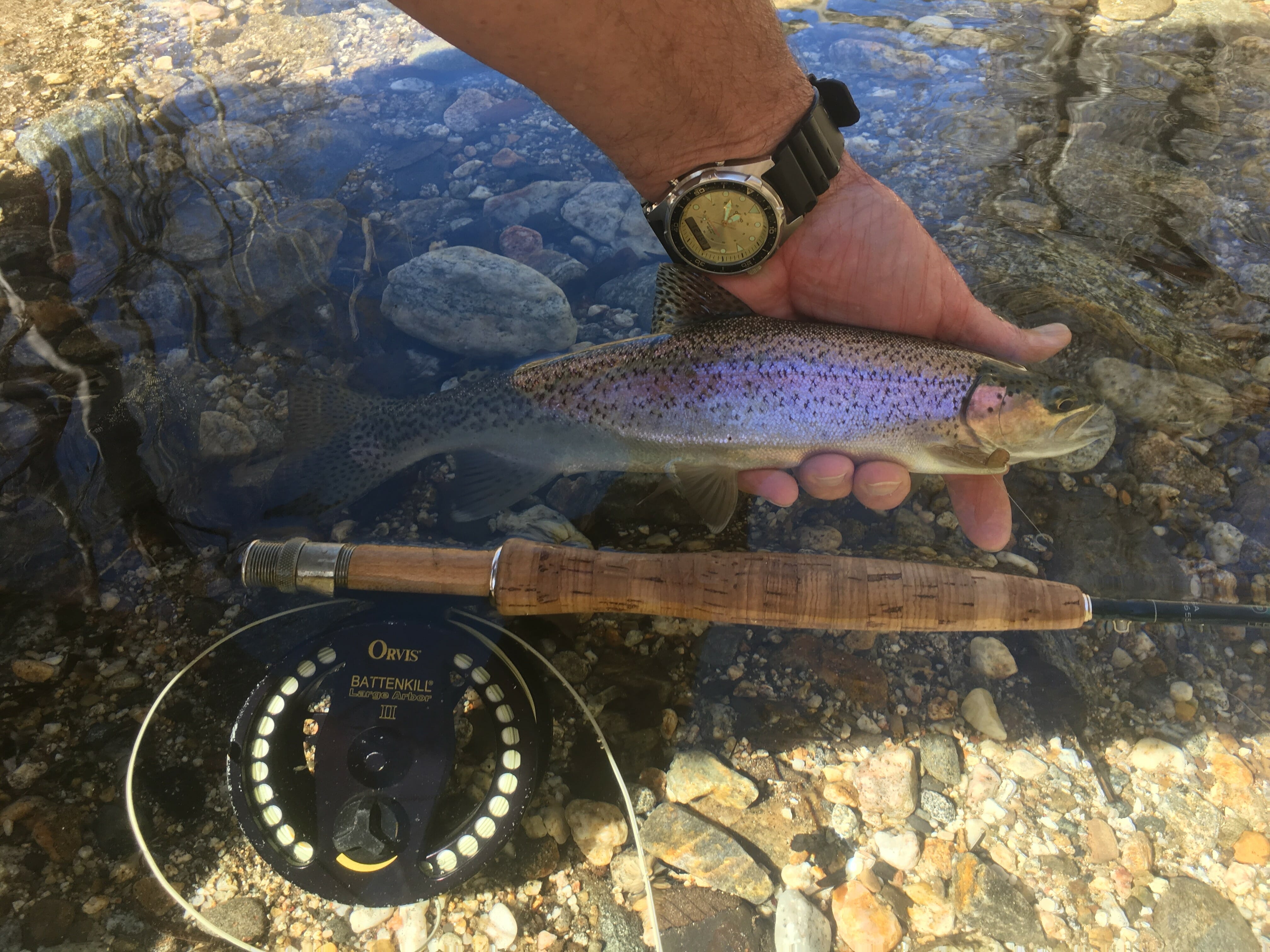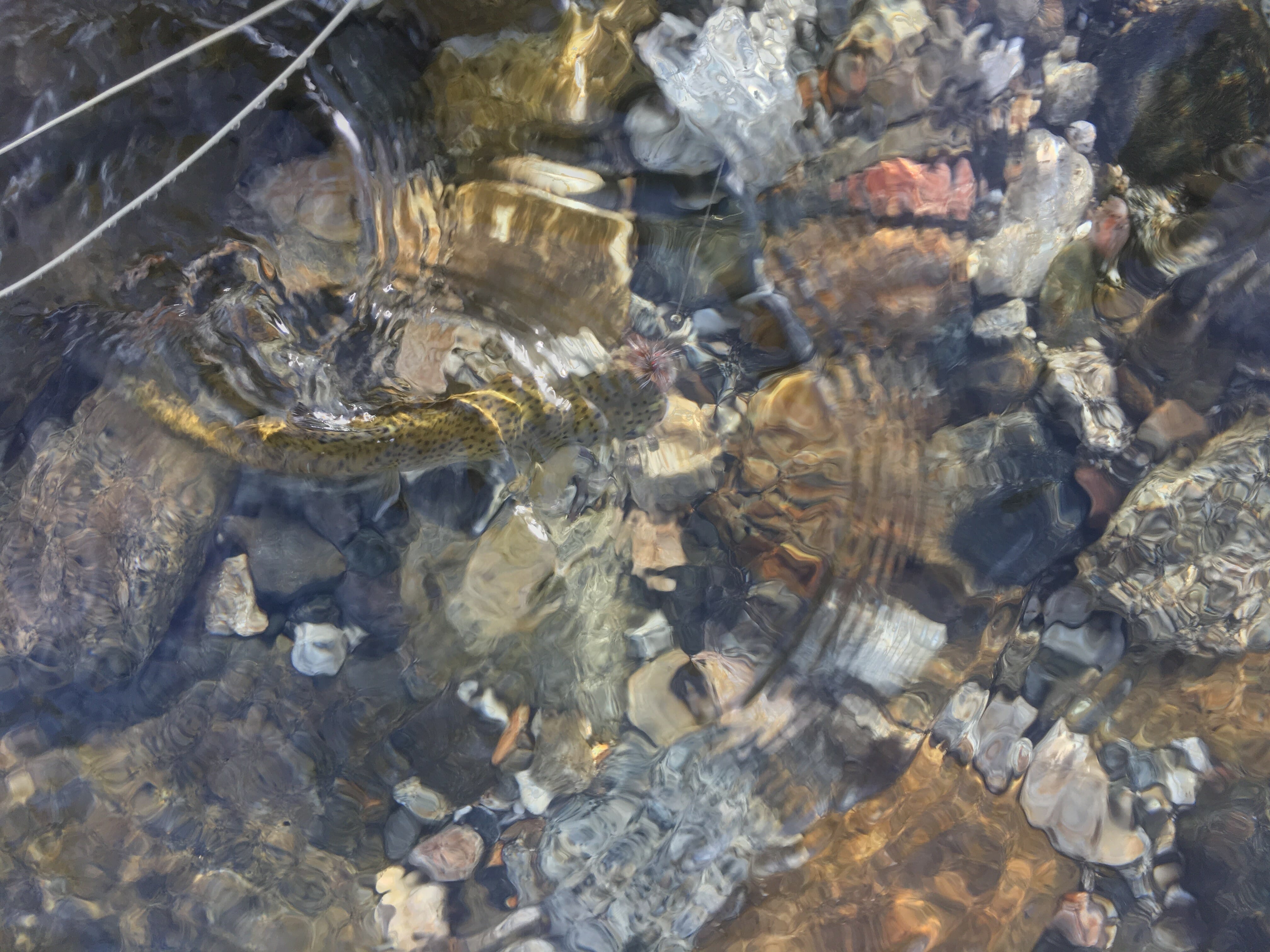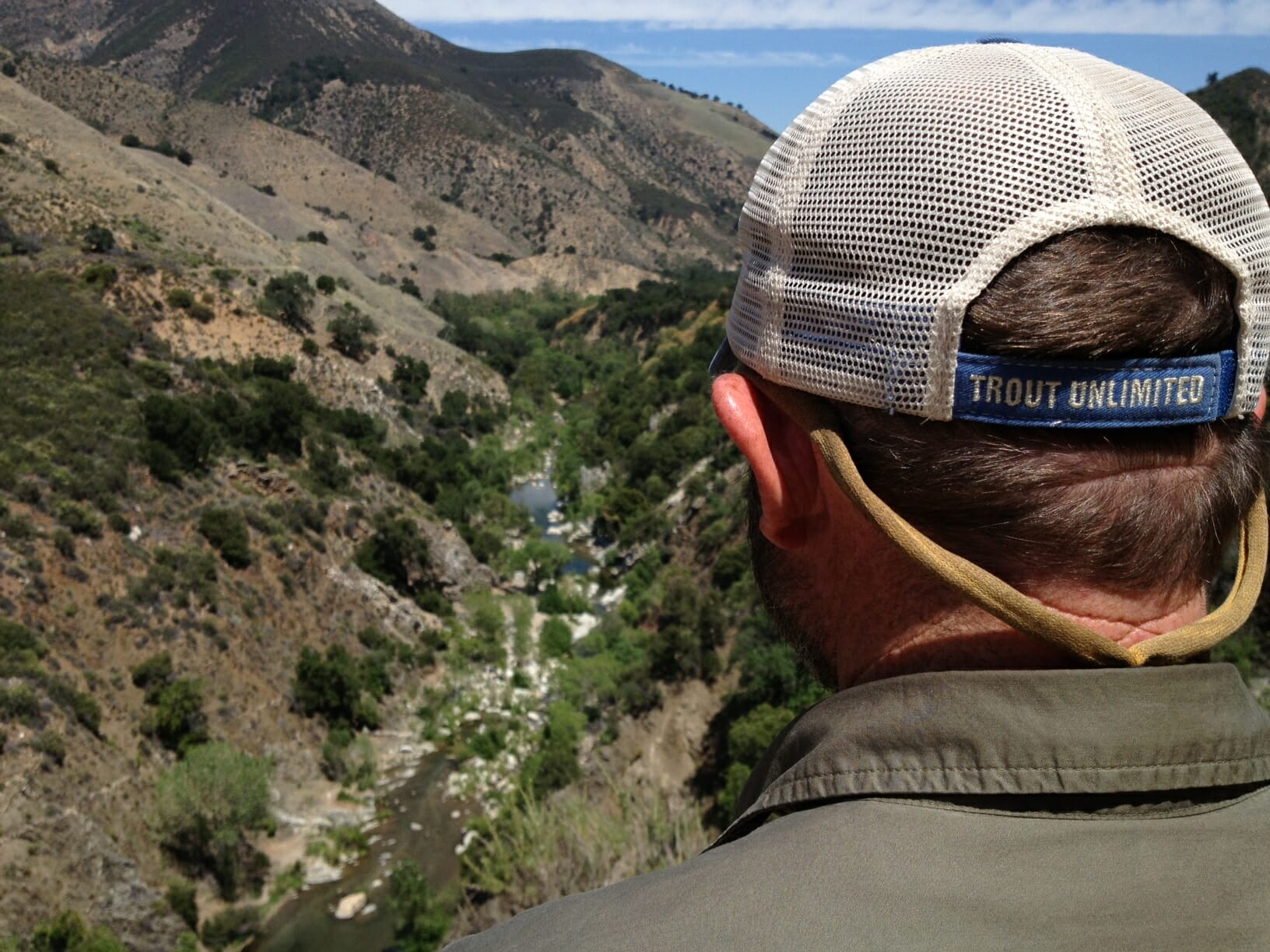The Arroyo Seco River.
By Sam Davidson
Not long ago, on an unseasonably warm Saturday, I went fishing in the desert.
Well, technically the Arroyo Seco River isn’t desert—the fishable section flows through a rugged canyon sheathed in cha
parral. But it might as well be in the desert. It’s hot and dry there much of the year, cactus and yucca cling to the rocky sides of the canyon, and the river corridor feels like an oasis, animal tracks here and there along its banks, draped with sycamores and cool, languid air.
Its desert
aspect notwithstanding, the Arroyo Seco is an important watershed for anglers, conservationists and resource managers. For one, above its connection with the Salinas River floodplain, it has not been dammed or overdeveloped. Its sources in the Ventana Wilderness of the Los Padres National Forest deliver cold, clean water to the lower canyon. And, when conditions are right, the Arroyo Seco produces steelhead.
 (L) The scene of the first cast.
(L) The scene of the first cast.
TMP and I went looking for those steelhead on that bright weekend morning. And we found them. Sort of.
Just past the Forest Service entrance station, we pulled in to a day use area and evaluated our prospects.
The river ran low and clear, thanks to a winter of virtually no rain whatsoever (in fact, over 90 percent of California is now in some level of drought again). There were long, deep runs and slow, shallow sections connected by short riffles. The phrase “gin clear” didn’t do that water justice.
A little stealth and some fine tippet seemed appropriate. So we rigged up a 4 wt. and, optimistically, tied on a size 14 elk hair caddis.
Special regulations apply to fishing on the Arroyo Seco—and to all other coastal streams in this region—due to the past and possible current presence of sea-run O. mykiss. From December 1 through March 7, you can only fish on Wednesdays, weekends and holidays. On some streams there are flow thresholds below which angling is prohibited.
Other considerations also apply to fishing the Arroyo Seco. The river is popular for family recreation. The day we were there, in early February, there were kids in bikinis and surf trunks, swimming and carrying on as if it were the dog days of summer.
 (R) The first fish.
(R) The first fish.
As you might imagine, our fishing expectations were modest.
TMP and I made our way over large cobbles of gneiss, granite and orange sandstone to the river’s edge. The channel made a gentle bend above one of those deep runs where it appeared to undercut the bank. The surface of the water where it ran along the bank was slightly ruffled.
I plopped that caddis next to some exposed tree roots. The fly drifted nicely along the seam. Was that movement?
Once, then twice more I made that cast. And on the third drift, a comely shape emerged from the depths, inhaled the fly, and sank back beneath the surface.
It happened so slowly and effortlessly, I was caught a little off guard. At length I raised the rod tip.
A minute or two later, a fine resident rainbow came to hand.
Well now, I thought. This could be interesting.
The next likely holding water produced no trout. But the next little riffle-pool, ah. A handful of 6-8 inch trout battered the poor caddis fly. TMP caught a couple of them, marveling at their perfect coloration and spotting.

TMP retired to the shade. I decided to explore a little.
I wet-waded across at the tail end of the “swimming hole” and made my way upstream. It was easy going, for the most part. Not far up river the stream necked down into a series of plunge pools. I threaded my way through willows and boulders to reach suitable casting stances.
Nothing in the swirls of the first pool I tried, just downstream of my position. I pivoted and cast upstream, into a tasty tub of frothy green water.
A breeze caught my line and blew the short roll cast off target. The well-masticated caddis dropped next to a boulder, nowhere near the seam I meant to reach. I started to initiate another roll cast.
At that moment my fly disappeared and a hulking shadow was briefly visible. I set the hook.
I never got a good look at that fish, as my dalliance with it was over almost as soon as it began. The trout charged rhino-like upstream. I dropped the rod tip and let go the line—to no avail. That 5x tippet offered little resistance, and came wafting back to me, empty.
I felt that thrilling, big-fish vibration coursing through my body.
Under the federal recovery plan for steelhead streams between Santa Cruz and Santa Maria, the Arroyo Seco is a high priority watershed for conservation efforts. Trout Unlimited’s Steinbeck Country Chapter and Central Coast Steelhead Coordinator Tim Frahm are thus working on current or prospective projects on the Arroyo Seco, to improve fish passage, remove non-native vegetation, and raise the water table downstream of the canyon so it will connect to the Salinas more easily.
 (R) TU’s Tim Frahm surveys the Arroyo Seco River canyon.
(R) TU’s Tim Frahm surveys the Arroyo Seco River canyon.
There are other, trout-fishable desert streams in California. Such waters are particularly vulnerable to damage or degradation, especially in this era of warming temperatures and more variable precipitation. Fortunately, desert streams such as the Whitewater, San Gabriel, and Santa Ana rivers (and their fishing opportunities) are now better protected as part of national monuments.
But rivers like the Arroyo Seco have no special designation—yet. The Forest Service has recommended that Congress designate 19 miles of the river as Wild and Scenic River. TU supports this designation, which would ensure that no new dams or water diversions could be developed in this river segment.
Right now the Arroyo Seco doesn’t have any steelhead in it. The river is the largest tributary to the Salinas River, and so far this winter there hasn’t been enough flow to connect the two. But it does have resident rainbows, some of them clearly of substantial size. And thanks to the remarkable life history diversity of O. mykiss, if we can keep the Arroyo Seco’s stream habitat in good shape, these trout will become steelhead when conditions are favorable.
Sam Davidson is TU’s Communications Director for California and Oregon.



